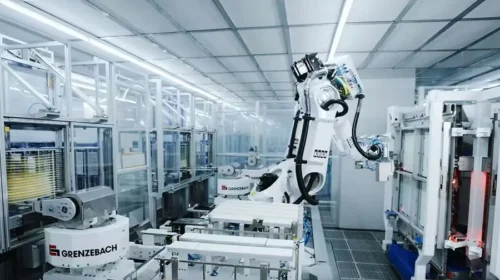Why aim small? 51World Digital Twin sets its sights on cloning Earth

The company has filed for a Hong Kong IPO, seeking funds that would, among other things, help to finance its plan to digitally clone the Earth’s 510 million square kilometers
Key Takeaways:
- 51World Digital Twin Tech has filed to list in Hong Kong, reporting 420 million yuan in combined losses between 2021 and 2023
- The company is China’s biggest provider of digital twin solutions, but still only controls 2.4% of the fragmented market
By Lee Shih Ta
Digital economy concepts have been investor darlings for quite some time, unleashing a wave of creativity from entrepreneurs hoping to tap into the next big futuristic business model using cutting-edge technologies. While entrepreneurs toil at turning abstract concepts into products with real-world marketability, the digital twin sector is moving in the opposite direction – seeking to take real-world objects to the digital realm.
Now, Beijing 51World Digital Twin Technology Co. Ltd., a leader in this emerging field, is hoping to bring its virtual skills to the capital markets with its recent filing for a Hong Kong IPO, with CICC and Huatai International as joint sponsors. It’s the fifth tech company to file for an IPO under Hong Kong’s Chapter 18C introduced this year, easing requirements for “specialist technology companies.”
The digital twin concept at the heart of 51World’s business refers to digitally replicating and simulating physical objects, systems or processes from real life into the digital realm. Those virtual items can then be used to simulate, verify, predict or control the full life cycle of the original physical objects to create connections between the real and virtual worlds and assist in better decision-making and management.
Generally speaking, digital twins are most often used in industrial manufacturing. The technology can increase the reliability and usability of products and decrease risks associated with product development and manufacturing. In recent years, with the help of technologies such as smart sensors, cloud computing, big data and AI, digital twins can also be applied in a wide range of areas from urban management to smart driving, architectural design and environmental protection.
Cloning Earth
The company, whose 51World moniker in Chinese sounds like “I want the world,” was founded in 2015, focusing on 3D graphics, simulation, and AI, and providing digital twin products and solutions. In 2017, it launched its most ambitious project, called Earth Clone, aiming to create a digital twin Earth in the virtual world using a super-sized simulator.
With that vision in mind, it rolled out three core businesses, namely 51Aes, a digital twin platform; 51Sim, a synthetic data and simulation platform; and 51Earth, a digital Earth platform. Most of its current revenue, about 80% last year, comes from the 51Aes business.
According to third-party market data in its listing document, 51World is the biggest Chinese provider of digital twin solutions based on related revenue in 2023. It is also the only one-stop provider of digital twin solutions. Even so, it still only accounted for 2.4% of the market last year, showing how fragmented and competitive the space is.
The company has conducted eight funding rounds to date, raising a total of around 830 million yuan ($114 million), valuing it at 4.4 billion yuan after the latest round. Its backers include the likes of Lightspeed China Partners, Sky9 Capital, Star VC, SenseTime and Moore Threads.
The company’s revenue has grown rapidly as its business expands, doubling from 130 million yuan in 2021 to 260 million yuan last year, when the figure grew by 50.6% year-on-year. But the growth rate slowed sharply to just 12.3% in the first half of this year, when the figure reached 33 million yuan.
Big losses
Despite the strong revenue growth, at least through last year, the company is still mired in red ink. It lost a total of 423 million yuan over the three years from 2021 to 2023. It lost another 65.1 million yuan in the first half of this year, though that was 35% narrower than the same period last year.
Meanwhile, the company’s gross margin is also on the decline, falling from 65.2% in 2021 to 50% in the first half of this year – never a good sign for a startup whose margin should be improving with its growing scale and experience. It acknowledged that structural changes in its sales costs had an impact on its gross profit and said it would try to bring down development expenses in the future by accumulating its own intellectual property rights and technologies.
In the run-up to an IPO, the company has been trying to show investors it can control costs, including R&D that is central to its business but also a major expense. Its R&D spending totaled 28.6 million yuan in the first half of this year, down 48% year-on-year, and roughly half as much as the 51.4 million yuan it spent on sales and administrative expenses combined during that time.
In terms of financial reserves, the company was sitting on 270 million yuan in cash by the end of June this year – not a huge amount considering its tens of millions of yuan in expenditures in the first half of the year.
Where’s the value?
Digital twins are winning plenty of policy support in China as an important part of the digital economy. According to data in the listing document, China’s digital twin solutions market grew from 2.7 billion yuan in 2019 to 10.7 billion yuan last year, with an annual compound growth rate of 40.8% that was faster than the global average. The China market is expected to continue growing at a fast clip to reach 66 billion yuan by 2028.
The digital twin concept first began to take off with the metaverse craze popularized by Facebook co-founder Mark Zuckerberg several years ago. But the concept is still rather new to most people even today, lacking clear commercialization pathways and market perceptions. Qiu Baoxing, China’s former vice minister of Housing and Urban-Rural Development, once said that “80% of digital twins are useless,” pointing to issues of data overload, difficulty of updating data and high modeling costs.
Without any profits on the horizon, 51World will need to keep burning through its cash and raise more financing to keep its business going. But that said, cost-cutting by slashing its R&D budget carries its own risks for this kind of growth company still at an early stage in its development, which could ultimately cause it to lose its first-mover advantage.
To subscribe to Bamboo Works weekly free newsletter, click here





